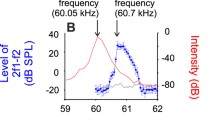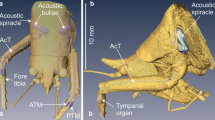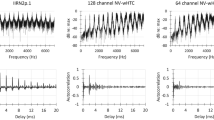Abstract
Behavioral auditory thresholds of Phyllostomus discolor are characterized by two threshold minima separated by an insensitive region at about 55 kHz (Esser and Daucher 1996). To investigate whether these characteristics are due to cochlear properties, we recorded distortion product otoacoustic emissions (DPOAEs) and calculated relative DPOAE threshold curves, which proved to be a good measure of cochlear sensitivity. Our results indicate that in P. discolor, cochlear sensitivity, as assessed by DPOAE recordings, does not show a threshold maximum at 55 kHz. The DPOAE threshold curves display an absolute minimum at approximately 30 kHz, and from that frequency region, the threshold continuously increases without any pronounced irregularities. The frequency tuning properties of the cochlea, as assessed by DPOAE suppression tuning curves (STCs) reveal broad filter bandwidths with Q10dB values between 3.4 and 10.7. There are no frequency-specific specializations of cochlear tuning. The characteristic pattern of subsequent threshold maxima and minima at high frequencies observed in behavioral studies seems to be shaped by transfer characteristics of the outer ear and/or neuronal processing in the ascending auditory pathway rather than by cochlear mechanics.





Similar content being viewed by others
References
Brown AM, Gaskill SA (1990) Measurement of acoustic distortion reveals underlying similarities between human and rodent mechanical responses. J Acoust Soc Am 88:840–849
Brown M, Kemp DT (1984) Suppressibility of the 2f1−f2 stimulated acoustic emissions in gerbil and man. Hear Res 13(1):29–37
Bruns V, Schmieszek E (1980) Cochlear innervation in the greater horseshoe bat: demonstration of an acoustic fovea. Hear Res 3(1):27–43
Drexl M, Kössl M (2003) Sound-evoked efferent effects on cochlear mechanics of the mustached bat. Hear Res 184(1–2):61–74
Esser KH (1994) Audio-vocal learning in a non-human mammal: the lesser spear-nosed bat Phyllostomus discolor. Neuroreport 5(14):1718–1720
Esser KH, Daucher A (1996) Hearing in the FM-bat Phyllostomus discolor: a behavioral audiogram. J Comp Physiol A 178(6):779–785
Esser KH, Lud B (1997) Discrimination of sinusoidally frequency modulated sound signals mimicking species-specific communication calls in the FM-bat Phyllostomus discolor. J Comp Physiol A 180(5):513–522
Esser KH, Schubert J (1998) Vocal dialects in the lesser spear-nosed bat Phyllostomus discolor. Naturwissenschaften 85:347–349
Faulstich M, Kössl M, Reimer K (1996) Analysis of non-linear cochlear mechanics in the marsupial Monodelphis domestica: ancestral and modern mammalian features. Hear Res 94(1–2):47–53
Firzlaff U, Schuller G (2003) Spectral directionality of the external ear of the lesser spear-nosed bat, Phyllostomus discolor. Hear Res 185:110–122
Foeller E, Kössl M (2000) Mechanical adaptations for echolocation in the cochlea of the bat Hipposideros lankadiva. J Comp Physiol A 186(9):859–870
Frank G, Kössl M (1995) The shape of 2f1−f2 suppression tuning curves reflects basilar membrane specializations in the mustached bat, Pteronotus parnellii. Hear Res 83(1–2):151–160
Habersetzer J, Storch G (1992) Cochlea size in extant chiroptera and middle Eocene microchiropterans from Messel. Naturwissenschaften 79:462–466
Heffner RS, Koay G, Heffner HE (2003) Hearing in American leaf-nosed bats. III: Artibeus jamaicensis. Hear Res 184(1–2):113–122
Kemp DT (2002) Otoacoustic emissions, their origin in cochlear function and use. Br Med Bull 63:223–241
Koay G, Bitter KS, Heffner HE, Heffner RS (2002) Hearing in American leaf-nosed bats. I: Phyllostomus hastatus. Hear Res 171(1–2):96–102
Koay G, Heffner RS, Bitter KS, Heffner HE (2003). Hearing in American leaf-nosed bats. II: Carollia perspicillata. Hear Res 178(1–2):27–34
Köppl C, Gleich O, Manley GA (1993) An auditory fovea in the barn owl cochlea. J Comp Physiol A 171(6):695–704
Kössl M (1992) High frequency distortion products from the ears of two bat species, Megaderma lyra and Carollia perspicillata. Hear Res 60(2):156–164
Kössl M (1994) Otoacoustic emissions from the cochlea of the ’constant frequency’ bats, Pteronotus parnellii and Rhinolophus rouxi. Hear Res 72(1–2):59–72
Kössl M, Russell IJ (1995) Basilar membrane resonance in the cochlea of the mustached bat. Proc Natl Acad Sci USA 92(1):276–279
Kössl M, Vater M (1996a) A tectorial membrane fovea in the cochlea of the mustached bat. Naturwissenschaften 83(2):89–91
Kössl M, Vater M (1996b) Further studies on the mechanics of the cochlear partition in the mustached bat. II. A second cochlear frequency map derived from acoustic distortion products. Hear Res 96(1–2):78–86
Kössl M, Mayer F, Frank G, Faulstich M, Russell IJ (1999) Evolutionary adaptations of cochlear function in Jamaican mormoopid bats. J Comp Physiol A 185(3):217–228
Lonsbury-Martin BL, Martin GK, Probst R, Coats AC (1987) Acoustic distortion product in rabbit ear canal. I. Basic features and physiological vulnerability. Hear Res 28:173–189
Martin GK, Lonsbury-Martin BL, Probst R, Scheinin SA, Coats AC (1987) Acoustic distortion products in rabbit ear canal. II: Sites of origin revealed by suppression contours and pure-tone exposures. Hear Res 28(2–3):191–208
Müller M, Laube B, Burda H, Bruns V (1992) Structure and function of the cochlea in the African mole rat (Cryptomys hottentotus)—evidence for a low-frequency acoustic fovea. J Comp Physiol A 171(4):469–476
Nowak RM (1991) Walker’s mammals of the world. John Hopkins University Press, London
Probst R, Lonsbury-Martin BL, Martin GK (1991). A review of otoacoustic emissions. J Acoust Soc Am 89(5):2027–2067
Robles L, Ruggero MA (2001) Mechanics of the mammalian cochlea. Physiol Rev 81(3):1305–1352
Rother G, Schmidt U (1983) Der Einfluss visueller Information auf die Echoortung bei Phyllostomus discolor (Chiroptera). Z Säugetierk 47(1):324–334
Sterbing SJ (2002) Postnatal development of vocalizations and hearing in the phyllostomid bat, Carollia perspicillata. J Mammal 83(2):516–525
Ulfendahl M (1997) Mechanical responses of the mammalian cochlea. Prog Neurobiol 53(3):331–380
Vater M, Siefer W (1995) The cochlea of Tadarida brasiliensis: specialized functional organization in a generalized bat. Hear Res 91(1–2):178–195
Whitehead ML, Stagner BB, Martin GK, Lonsbury-Martin BL (1996) Visualization of the onset of distortion-product otoacoustic emissions, and measurement of their latency. J Acoust Soc Am 100:1663–1679
Acknowledgements
We thank C. Abel for his help during the experiment. The experiments reported here comply with the “Principles of Animal Care” (publication No. 86-23, revised 1985 of the NIH) and also with current German laws. This study was supported by the DFG, Ko 987.
Author information
Authors and Affiliations
Corresponding author
Rights and permissions
About this article
Cite this article
Wittekindt, A., Drexl, M. & Kössl, M. Cochlear sensitivity in the lesser spear-nosed bat, Phyllostomus discolor. J Comp Physiol A 191, 31–36 (2005). https://doi.org/10.1007/s00359-004-0564-x
Received:
Revised:
Accepted:
Published:
Issue Date:
DOI: https://doi.org/10.1007/s00359-004-0564-x




